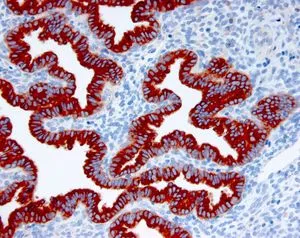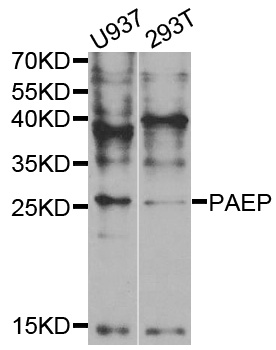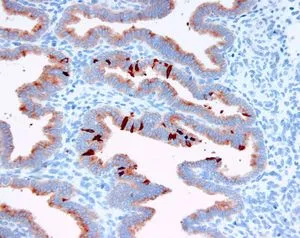
Staining is restricted to the glandular cells in formalin-fixed paraffin-embedded endometrial tissue from the late secretory phase, stained with GTX60956
Glycodelin antibody [001-13]
GTX60956
ApplicationsELISA, ImmunoHistoChemistry, ImmunoHistoChemistry Paraffin
Product group Antibodies
TargetPAEP
Overview
- SupplierGeneTex
- Product NameGlycodelin antibody [001-13]
- Delivery Days Customer9
- ApplicationsELISA, ImmunoHistoChemistry, ImmunoHistoChemistry Paraffin
- CertificationResearch Use Only
- ClonalityMonoclonal
- Clone ID001-13
- ConjugateUnconjugated
- Gene ID5047
- Target namePAEP
- Target descriptionprogestagen associated endometrial protein
- Target synonymsGD, GdA, GdF, GdS, PAEG, PEP, PP14, ZIF-1, glycodelin, PEG, PP14 protein (placental protein 14), alpha uterine protein, glycodelin-A, glycodelin-F, glycodelin-S, placental protein 14, pregnancy-associated endometrial alpha-2 globulin, progestagen-associated endometrial protein (placental protein 14, pregnancy-associated endometrial a, progesterone-associated endometrial protein, zona-binding inhibitory factor-1
- HostMouse
- IsotypeIgG1
- Protein IDP09466
- Protein NameGlycodelin
- Scientific DescriptionThis gene is a member of the kernel lipocalin superfamily whose members share relatively low sequence similarity but have highly conserved exon/intron structure and three-dimensional protein folding. Most lipocalins are clustered on the long arm of chromosome 9. The encoded glycoprotein has been previously referred to as pregnancy-associated endometrial alpha-2-globulin, placental protein 14, and glycodelin, but has been officially named progestagen-associated endometrial protein. Three distinct forms, with identical protein backbones but different glycosylation profiles, are found in amniotic fluid, follicular fluid and seminal plasma of the reproductive system. These glycoproteins have distinct and essential roles in regulating a uterine environment suitable for pregnancy and in the timing and occurrence of the appropriate sequence of events in the fertilization process. Alternative splicing results in multiple transcript variants. [provided by RefSeq, Oct 2015]
- Storage Instruction2°C to 8°C
- UNSPSC12352203






